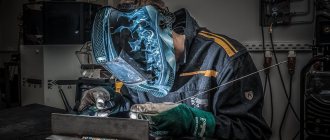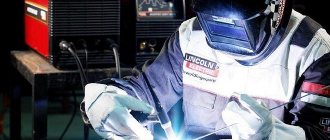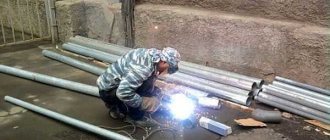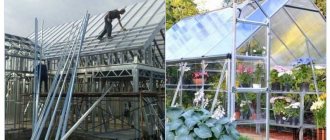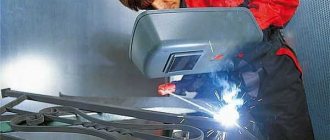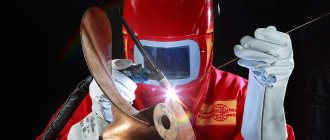The inverter, which replaced conventional welding transformers, is a modern electronic device, the characteristics of which allow it to be used for welding work using various technologies. In addition to the basic characteristics characteristic of transformer-type welding machines, inverters also have a number of additional capabilities, which makes their use more convenient and significantly expands their technical capabilities. Thanks to this, such equipment can be used equally successfully in both industrial and home environments.
Welding inverter “Svarog” ARC-200
Operating principle of a welding inverter
A welding inverter is a powerful power supply, which in terms of energy conversion is similar to a switching power supply.
The main stages of energy conversion in the inverter:
- Reception and rectification of network current with a voltage of 220 V and a frequency of 50 Hz.
- Converting the resulting rectified current into alternating current with a high frequency from 20 to 50 kHz.
- Reduction and rectification of high-frequency alternating current into a current whose strength is in the range of 100 ... 200 A, and a voltage from 70 to 90 V.
Converting high-frequency electric current to a current of the required value allows you to get away from the inconvenient dimensions and heavy weight of the inverter, which are found in conventional transformer devices, in which the current value is achieved by converting the EMF in an induction coil. Also, when the welding inverter is connected to the network, there will be no sharp jumps in electrical energy, and moreover, the device contains in its circuit special storage capacitors that protect the machine when welding during an unexpected power outage and allow the inverter arc to be ignited more gently.
Arc welding diagram
Obtaining a high-quality weld when welding depends on many factors, therefore, before starting work, the master must familiarize himself with how to properly use the inverter according to the attached instructions, as well as the basic rules and nuances of performing welding work, which will be described in detail below.
Particular attention should be paid to the diameter of the welding electrodes. It is important to know that the amount of energy consumed directly depends on the thickness of the welding rods, and, accordingly, the larger their diameter, the higher the energy consumption. This information will help to correctly calculate the maximum electrical energy consumption of the inverter, which will prevent adverse consequences from its operation as reflected on household appliances. There is also a dependence of the diameter of the electrode on the current selected for the work, a decrease in which will lead to deterioration in the quality of the seam, and an increase - to an excessive combustion rate of the welded rod.
Types of inverters on the modern market
Welding inverters on the market today can be divided into two main types.
Household
A device such as a household inverter is designed to perform periodic welding work. These devices are inexpensive, but they can be used from time to time; they are not intended for intensive daily work. Such inverters are optimal if you sometimes need to perform simple and short-term welding work. Most of these devices are made in China.
Professional
Such equipment is intended for daily long-term use; its design is initially designed for active use. The cost of these inverters, naturally, is quite high, but it is adequate to their quality characteristics.
The market also offers semi-professional inverter devices, which, in terms of their technical characteristics and cost, are between household and professional equipment. In addition to the above types, there are universal devices, which are also called combined. Their versatility lies in the fact that they can be used to perform welding using various technologies. Due to its wide functionality, such inverter equipment also falls into the professional category.
Inverter design for welding
In order to understand how to properly use a welding machine, a novice master should familiarize himself with the design of the inverter.
The welding inverter is a metal box with internal components, a total weight of about 7 kg, which is equipped with a handle and a shoulder strap for ease of carrying. The housing of the welding inverter may contain ventilation holes that promote better air outflow when cooling the unit. The front panel has buttons for switching the operating state, knobs for selecting the required voltage and current, outputs for connecting work cables, as well as indicators indicating the presence of power and overheating of the inverter during welding. The cable for connecting the device to the power supply is usually connected to the connector located on the back of the inverter.
Welding inverter design
When the electrode comes into contact with the metal plates being welded during welding, a high-temperature arc is formed, as a result of which both the elements of the welded rod and the metal of the welded joint melt. The bath formed in the arc area by the molten metals of the plates and electrode is protected from oxidation by a liquefied coating of the electrode. After complete cooling of the metal, the upper surface of the seam, protected by electrode coating during welding, will turn into hardened slag, which can be easily removed by light mechanical action (for example, tapping). It is important to maintain the same distance-gap between the metal of the welded joint and the electrode (arc length), which will prevent its extinction. To do this, the supply of the electrode to the fusion area must be carried out at a constant speed, and the guidance of the welding rod along the weld joint must be smooth.
Welding arc
The best inverter devices
Before purchasing a specific welding machine, you should familiarize yourself with the ratings of the manufacturing companies.
Review of the best welding inverters:
- KRUGER WIK 300 A. A very convenient device, which is equipped with a plastic case. The support legs are equipped with a rubber gasket, which makes the structure stable on any type of surface.
- RESANTA SAI-190 is another very well-known representative of inverter devices. Due to the smooth arc, all welding seams are of high quality. The device automatically turns off when overheated. The indicator panel is simple and easy to use.
Wester MIG 140 is a universal model that provides manual and semi-automatic operation.
When using argon or carbon dioxide, you can join steel or aluminum parts very well. This model is rightfully recognized as one of the highest quality inverters with minimal noise levels, as well as an excellent cooling system.
Safety precautions
Before starting home welding, the electric welder needs to take care of safety precautions:
- wear a protective suit made of durable, high-density natural fabric that is not subject to fire and melting when sparks hit it. The suit should cover the neck area and have sleeves that fasten tightly at the wrist.
- protect your hands with mittens made of rough fabric;
- wear comfortable leather shoes with thick soles;
- Protect your eyes with a welder's mask with a light filter that depends on the current strength during welding.
The place where welding will be carried out must also be carefully prepared:
- a wooden flooring has been laid, which performs a protective function against possible electric shock;
- the welding site is cleared of anything unnecessary (to prevent welding splashes);
- lighting must be of high quality;
- The welder's movements should not be constrained.
Basics of welding with an inverter
Learning to weld with a welding inverter is not difficult. The very first stage of mastering welding techniques will be preparing the metal plates to be welded:
- cleaning the edges of the plates from traces of corrosion with a wire brush;
- degreasing the edge with a solvent.
Relying on the diameter of the electrodes, the choice of which is based on the grade of the metal being welded, it is necessary to select the current value for welding. The value of the welding current will also be determined by the cross-section of the elements being welded. To ensure that the quality of the seam is not affected when welding with an inverter, the pre-welded rods should be dried in an oven with a heating temperature of 200 º for 2-3 hours.
Methods for making welds
In order to weld metal, the ground terminal must be connected to the plane of the element being welded. Next you need to ignite the arc. You can do this in two ways:
- striking the metal surface of the plate, similar to igniting a match head;
- tapping the electrode on the surface to be welded.
Working with a welding inverter will be more convenient if, when welding, the holder cable is pressed to the body, having first wrapped it around the forearm of the working hand. In this position, the cable will not pull towards the holders and adjusting its position will be more convenient. Therefore, when choosing an inverter, special attention must be paid to the length and flexibility of the cables, because the convenience of the welder will depend on these indicators.
Correct cable position when welding
After igniting the arc, the electrode must be moved away from the plane of the metal plate to a distance equal to the length of the arc (approximately 2-3 mm) and welding can begin. To make high-quality welding, you must constantly monitor the length of the electric arc. A short arc (about 1 mm) can cause a welding defect called “undercut.” This welding defect is characterized by the appearance of a shallow groove parallel to the weld, leading to a decrease in the strength of the weld. A long arc is unstable, provides a lower temperature in the welding zone, and, as a result, such a seam has too small a depth and is “smeared”. A welder who knows how to properly adjust the arc length will receive a high-quality weld.
After welding is completed, you should carefully beat off the scale that has frozen on top of the seam with a hammer.
Advantages and disadvantages of inverters
The high popularity of inverters is explained by a number of advantages that they have.
- Inverters are distinguished by high power and a wide range of welding current regulation. — Even when the work is performed by a not very highly qualified specialist, inverter devices make it possible to obtain welds of high quality, reliability and attractive appearance.
- Inverters are compact in size and light in weight. — Devices of this type have high efficiency and, as a result, consume electrical energy economically.
- During welding with an inverter, the molten metal is splashed very slightly, which helps to save consumables and form neat welds.
- The versatility of inverter machines is undeniable, thanks to which they can be used to perform welding using different technologies.
Inverters also have disadvantages, the most significant of which include the following.
- Inverters are quite expensive when compared to conventional welding transformers.
- If they fail, inverter devices are very expensive to maintain.
- Inverters, whose design is based on complex electronic circuits, react very critically to dust, high humidity and low temperatures. That is why the scope of use of such devices is quite limited. For their trouble-free operation, it is necessary to create special conditions and devote a lot of time to their maintenance (cleaning from dust, etc.).
- Complete with inverter devices, wires whose length does not exceed 2.5 meters can be used. Such short wires are also factors that seriously limit the application range of inverters.
Overall, if you weigh the pros and cons of using inverters for welding, the benefits will be significantly greater. The design of the equipment ensures rapid ignition of the welding arc and its stable combustion during the work process, and thanks to its technical capabilities, inverters make it possible to obtain high-quality, reliable and accurate connections with electrodes of any type.
Polarity when welding with an inverter
Melting of the metal is caused by exposure to the high temperature of the welding arc, which occurs as a result of connecting the opposite terminals of the inverter to the metal plate and to the welding rod. Depending on the order of connecting the welding inverter terminals, a distinction is made between direct and reverse polarity.
The order of connecting the terminals for direct and reverse polarity
Polarity is the setting of the direction of electron movement. Both direct and reverse polarity are used when welding with an inverter, so it is important for a novice welder to know the differences between these types of connections.
Straight polarity is the polarity that occurs after connecting the electrode to the minus terminal and the metal plate to the plus terminal. With this connection, the current flows from the electrode to the metal, as a result of which the metal heats up more intensely, and the melting zone becomes sharply limited and deep. The direct polarity of connecting the welding inverter is selected when welding thick-walled elements and when inverter cutting.
Reverse polarity is characterized by connecting the “minus” to the metal plate, and the “plus” to the electrode. The fusion zone with this connection is wider and has a shallow depth. The direction of current is directed from the metal workpiece to the electrode, resulting in greater heating of the electrode. This procedure reduces the risk of burn-through and is used when welding thin-walled metal products.
Working with thin metal
Welding of thin-walled metal products with an inverter is carried out by connecting the terminals according to a circuit corresponding to reverse polarity and placing the electrode at an angle forward. This welding technique provides a smaller heating zone with sufficient seam width.
Ignition of the electrode should be done extremely carefully, because the beginning of the pool when welding thin metal is often accompanied by a burn-through. Welding thin metal with an inverter must be carried out gradually, welding small areas with a short-term removal of the electrode from the bath. At this moment, you need to make sure that the yellow glow of the electrode tip does not go out.
The quality of the weld directly depends on the quality of the electrodes, which will help avoid excessive formation of slag in a small-section weld. Also, the use of small-diameter electrodes avoids burning through the metal.
When completing a weld, you should not abruptly tear off the electrode to extinguish the arc, because in this case a noticeable crater will form at the end of the seam, which will worsen the strength of the metal of the welded joint and the result of the welding equipment will be unsatisfactory.
Another defect that often occurs when welding thin metal is deformation of the product. To prevent its occurrence, it is necessary to carefully secure the parts being welded before welding.
